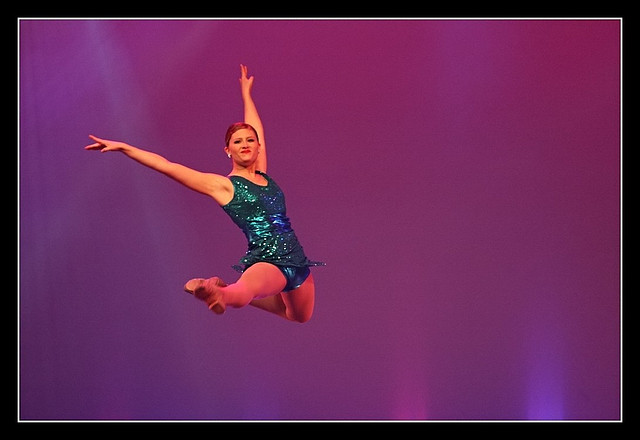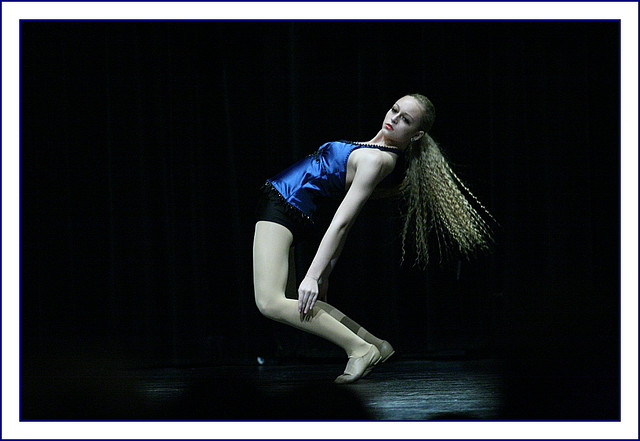
by Karen Musey
What matters more in a competitive piece – difficulty or execution?
I feel this quandary plagues a lot of competitive teams and dancers. A competing studio’s dancer executes a new “trick” successfully onstage and suddenly the bar of what is considering ranking in an age category jumps up. The pressure to stay current with the bar of excellence is then set, so obviously you need to start pushing yourself to do stuff you can’t do yet.
Really?
First of all, the reason I put “trick” in quotation marks is that I don’t really believe in the phrase. Yes, there are extremely difficult steps and sequences, but to call it a “trick” is simply slang for years and years of repeated practice. Even magicians (who perform “tricks” all of the time) don’t just suddenly decide that today is the day to try that very cool and nifty cutting-the-woman-in-a-box-in-two-thingy sword “trick”. For obvious, dangerous reasons.
My definition of a “trick” is a series of highly coordinated, synchronized movements that are performed in a certain sequence with timing.
I would much rather see simpler, cleaner lines and steps onstage in competition choreography than “tricks” – especially “tricks” that are not ready yet. As a judge, I’m not alone in that sentiment either. Seeing a young dancer get injured onstage because they were attempting a step they weren’t quite ready to do is frightening. Faking it until you make it, bravado and confidence in the moment are all great, but that should not take the place of long term, systematic training.
The problem with “tricks” is that sometimes they are attempted before the coordination and strength to support them is properly developed. Coordination develops with each year of a child’s growth; each year of training builds a new layer of muscle recognition and faster brain-to-body-part dexterity. It’s exactly like building a house with bricks. Skipping for very young children is super challenging; after a few years it is not a big deal because the coordination is now set in place. This is why judges continue to stress the importance of taking regular ballet classes. Dancers’ bodies need time and repetition to successfully develop the needed coordination to execute any step under pressure and without fear of injury.
To add to the complexity of successful training: bodies are not all built the same, nor is training consistent from one studio to the next.
I find it heartbreaking when I teach students who struggle as they get older because they have developed bad habits and injuries from been pushed too fast or worse – they skipped developmental training. They were taught a “trick” far before they were ready to execute it accurately with the proper muscle groupings and strength. When they were eight they were fearless and very flexible but had no muscle control so they “gripped” to hold on to a movement – that is what their body remembers.
This means the student and I have to slow down and go back to the basics and find the link in the chain that they didn’t fully incorporate into their movement vocabulary. It can be challenging for a dancer’s ego to go back to the basics, but it is very illuminating. You can’t hide irregularities and mis-balanced coordination in simple steps, but it is very easy to sweep it under the rug with faster, advanced movements. A slow rise in ballet first position will reveal an ankle wobble, a fast spring into relevé won’t. This is why many dancers think they have mastered a step long before their body actually has; the telltale sign is if they can perform it with ease, under pressure.

Of course, dance competitions are huge business in North America. The amount of hours for classes; the cost for costumes, hotels, work hours missed, and meals away from home all add up. Sometimes this creates pressure for studios or choreographers to deliver a certain difficulty of step in choreography that they believe is necessary in order to obtain a certain mark. Often this is why many dancers attempt fouettés (for example) onstage far too soon. If it is “the norm” and “what others are doing” then people feel pressured to also do the same, in order “to win”.
What actually happens – a dancer may be doing a fantastic job and is being marked higher initially, but then their mark falls because they have introduced an element that is too difficult for them (for the moment). You can tell when it is work onstage – the dancer suddenly stops performing. It would have been better for them not to include the difficult element until it was completely solid in classwork.
There is a wonderful thing that happens when training is systematic; when working at a level that challenges but doesn’t overwhelm; and when bad habits are reworked into healthy ones. Confidence! Having a solid technique to ground them allows a dancer to truly live in the moment onstage and to have complete freedom of expression.
Hopefully you have a dance teacher or studio owner who celebrates exactly where you are at. Not more, and not less. They challenge you with new steps and combinations in class; and come competition season they know exactly how to show you off to the best of your ability so that you walk off that stage knowing you nailed your number. You really know when you’ve pulled off a difficult step – it had flow, ease and your concentration was on performing, not on the execution of the step.
Young dancers especially want to know that they have done their parents and teachers right by giving it all they’ve got. No two dancers are the same, and the best we can do for them is to give them a unique movement vocabulary that will make them feel like they own that stage while they are gracing it.

Contributor Karen Musey is a dynamic Canadian born, New York based performer, teacher and dance adjudicator. Her training includes study at Canada’s Royal Winnipeg Ballet Professional Division, The Banff Centre, EDGE PAC (LA), Upright Citizen’s Brigade, The Barrow Group, Kimball Studio, Canada’s National Voice Intensive, Comic Strip Live and more.
Karen Musey judges national and regional dance competitions and festivals across the United States and Canada. She was a Director/Choreographer Observership Candidate during the 2011/12 season with Stage Directors and Choreographers Union and has served as a rehearsal director and dance captain for KOBA Family Entertainment. Karen Musey is an ABT® Certified Teacher, who has successfully completed the ABT® Teacher Training Intensive in Pre-Primary through Level 5 of the ABT® National Training Curriculum. She is a U.S. Member of the International Dance Council CID, recognized by UNESCO.
Performing highlights – PHISH at Madison Square Garden; World Premiere of the Canadian Opera Company’s Das Rheingold (Wagner Ring Cycle); National Artist Program Gala for the 2003 Canada Winter Games; for HRH Queen Elizabeth II during the Golden Jubliee Tour; Chicago (Rainbow Stage); comedy short Foreign Exchange (72 Hour Asian American Film Shootout); music videos for The Guards and Malynda Hale; international tours and performances with The Young Americans, J.A.R. Productions and KOBA Family Entertainment; stand up and sketch comedy around New York; Bravo! documentaries, films and more. She is currently co-writing a play. www.karenmusey.com





I could not agree with you more. As a teacher, with training that includes NBS, I also believe in the importance of a solid foundation; there is a reason why certain movements need to be given before others, why ALL of the barre exercises are important and cannot be “left out” or “abbreviated” if true technique is to be built. However, I have been fired by competition studios because I was “supposed to be working on the students’ technique, and instead had them exercising at the barre”; because I would not give multiple pirouettes and fouette turns to first year pointe students who were not yet capable of a releve on one foot; because I “wasted everyone’s time” by trying to teach a correct way to perform glissades, chasses, pas de bourrees, and spending time working on port de bras and use of the upper body. The list goes on. Still, I refuse to stop “wasting time by giving a barre”, or trying to build a solid foundation by teaching fundamentals before attempting to teach movements suitable for a very advanced level of technique . I have often found that young students enjoy working on simple movements, learning the names of the movements and what they mean, and being able to do the simple movements well relatively quickly. They take pride in showing that they remember the names of the steps and their meanings, and ask to repeat exercises from week to week; they have favourites that they like to work on, and look forward to mastering, and movements that they have practiced and are anxious to show the results. However, I know that by continuing in this way, I need to be prepared that the majority of times, it will result in me being fired.
Thanks for your comment Tess. I’m sorry that you have had bad experiences with this in terms of trying to lay the foundation for strong dancers. It’s my hope that you will find a match for your skills at a studio that values good training…I know they are out there!